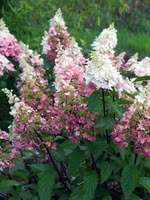Mon-Fri 9am - 5pm Mountain time
Black Elderberry vs Pinky Winky Hydrangea
Sambucus canadensis
Hydrangea paniculata Pinky Winky
NOT AVAILABLE THIS SEASON - MIGHT RETURN
CUSTOM GROW
Black Elderberry is a deciduous shrub native to eastern North America. You can plant this shrub in moist areas and it will help stabilize your soil. You can also use it on rural properties anywhere you'd use a lilac.
Black Elderberries are considered to be partially self-pollinating. So while they will still produce some berries without cross-pollination, planting with another variety will increase yields. Consider planting with Ranch Elderberry or Bob Gordon Elderberry.
Warning: the seeds, stems, leaves, roots, and uncooked berries of the Black Elderberry are poisonous to humans when eaten in quantity. You should cook the berries to make them safe for human consumption.
Pinky Winky Hydrangea is an adaptable and tolerant hydrangea variety with unusual flowers. In late summer, clusters of white blooms emerge, transforming to shades of pink and white. This two-toned effect is outstanding and will make a stunning flowering addition to your yard.
Try Pinky Winky Hydrangea in mass plantings or as an accent plant on its own, just make sure you mulch the root system to help insulate in colder climates.
Black Elderberry Quick Facts
Pinky Winky Hydrangea Quick Facts
Toxicity: leaves, stems, and uncooked berries are poisonous to humans

